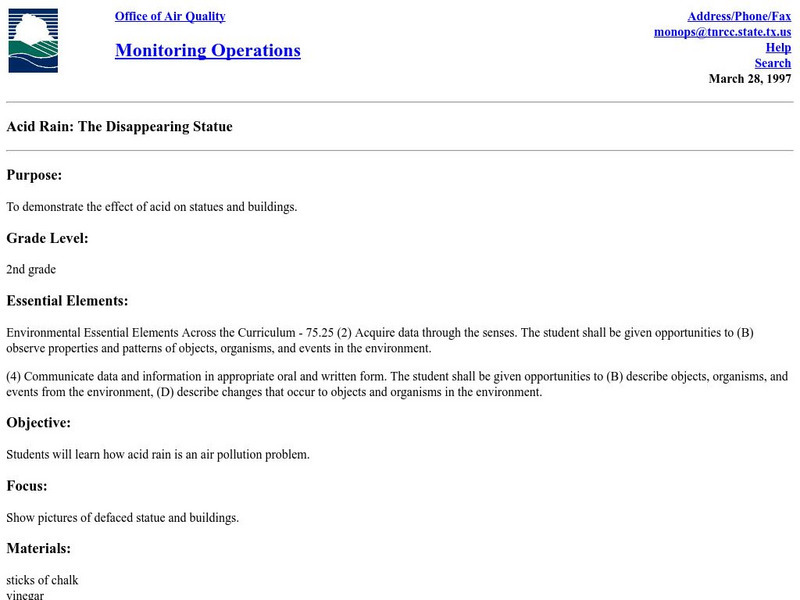Curated OER
A Rocky Situation
Second graders conduct experiments with rocks to observe weathering. They read books, examine websites and watch a video to examine how rocks break down into soil.
Curated OER
How They Get Building Materials Out of the Ground
Students experience a virtual quarry. In this science musical lesson plan, students understand how materials are quarried and manufactured from rocks, musically interpret a quarrying sequence with untuned musical instruments, and...
Curated OER
Acid Rain And How It Affects Our Environment
Learners explore acid rain. In this science lesson plan, students demonstrate phenomenologically the effects of acid rain on our environment and perform long-term "real-time" experiments.
Curated OER
Aquifers
Students participate in an experiment about aquifers. They answer questons and make observations about the experiment. They discuss how they can make a difference in the way water is used.
Curated OER
Speleothem Formations
Students examine how speleothem formations can be simulated. Students follow directions carefully in this laboratory experiment, and keep a written account of everything they observe. After five days, the students share their experiment...
Curated OER
Physical Properties Of Coal
Students examine and identify the observable properties of coal. After a lecture/demo, students perform a simple experiment. They observe samples of coal and record data in an organized manner.
Curated OER
Acid Rain: The Disappearing Statue
Second graders examine the effects of acid rain on statues and buildings. They participate in an experiment in which they use different chemicals on building materials. They observe and record their observations.
Curated OER
Acid Rain: An Air Pollutant
Fifth graders participate in an experiment in which they examine the effects of acid rain on buildings. They discover how huge a problem acid rain is not only to structures but to the environment. They gather pictures of acid rain to...
Curated OER
Aquifers: Unlimited or Not
Learners understand that an aquifer can become a non-renewable resource if it is not used wisely. Students do an experiment that recreates an aquifer in the classroom.
Curated OER
Bricks Soak Up Water
Pupils determine whether various rocks are porous or not. They conduct an experiment to determine if a brick is porous, calculate how much water the brick soaked up, and develop a conclusion.
Curated OER
Decomposing Artifacts
Seventh graders participate in an experiment in which they calculate the time of decomposition of different materials. In groups, they fill bags with different materials and cover them in soil. After six months, they create a line graph...
Curated OER
Sandwich Stratigraphy
Two activities are included in this resource. In the first, junior geologists model sedimentary rock layers, apply the Law of Superposition, and demonstrate folding and faulting of the Earth's crust. The model is technically a sandwich....
Curated OER
Breaking it Down
High schoolers will identify the factors that contribute to erosion and weathering. They will start by differentiating between chemical and mechanical weathering. They then apply what they learned by playing the online jeopardy game. Key...
Curated OER
Rocks and Minerals
Students investigate the properties and uses of rocks and minerals. They build towers using only one material from a pile of stones, tiles, wood, etc. provided by the teacher. Students test the hardness of rocks by scratching them with...
Curated OER
Let's Rock
Students investigate the property of rocks and how to distinguish among the different types. They explore the hardness of rocks and perform streak tests to determine mineral color. They classify rocks according to their properties.
Curated OER
Dust in the Wind; Chemicals in the Water
Students explore mechanical and chemical weathering at stations. They articulate some mechanisms of chemical and mechanical weathering through exploration in a lab. Students stations describe how chemical weathering differs from...
Curated OER
Pyrites
Pupils examine the mineral pyrite and discover the differences between it and gold. In this mineral instructional activity students identify minerals using their common properties.
Curated OER
Exothermic Rehydration of Gypsum
Students observe exothermic reactions in the lab using plaster. In this chemistry lesson, students collect data from their experimental set up every five minutes. They explain the different stages in the hardening of plaster.
Curated OER
Virtual Field Trip
Fifth graders are introduced to the concepts of weathering and erosion. In groups, they rotate between different stations to discover how each process effects different landforms. To end the lesson, they discuss each change in the...
Curated OER
Forest Forensics
Learners explore forests. In this "forest forensic" lesson students divide into groups and go through the stations using their clues to solve the questions.
Curated OER
Take Me to the River! Using the Black River for Earth Science Review
Ninth graders use maps to identify landscape regions and drainage patterns producing the Black River. They create PowerPoint presentations pertaining to the Black River watershed, its geologic history and highlighting safe rafting...
Curated OER
How Does Mining Produce Acid Runoff?
Students examine how mining and other industry operations can lead to acid runoff. In this mining lesson students study weathering and complete a lab on it.
National Association of Geoscience Teachers
Nagt: Illinois Caverns Field Trip
Take your students on a caving experience. This field trip gives hands-on experiences with stalactites, flow stone, fossils, water erosion, limestone, and groundwater.
Michigan Reach Out
Reach Out Michigan: Acid Rain
This experiment from Reach Out Michigan "demonstrates the effect of acid rain on statues and buildings."























